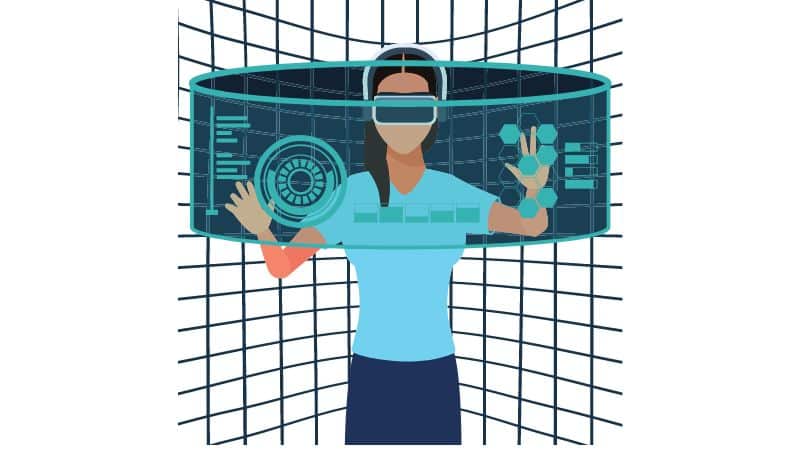Advertisements
Are you prepared to embark on an exhilarating journey through the dynamic and ever-evolving realm of tech innovations? Look no further as we guide you through the latest advancements that are revolutionizing the tech industry. From groundbreaking devices to innovative software solutions, these developments are reshaping the ways we live, work, and interact.
Whether it’s artificial intelligence, virtual reality, or the Internet of Things, a plethora of cutting-edge technologies awaits exploration. With each passing day, new breakthroughs emerge, pushing the boundaries of what was once deemed possible.
But what distinguishes these innovations? It’s not merely about flashy features or the latest gadgets; it’s about how they enrich our lives, streamline our tasks, and foster novel connections. Across healthcare, transportation, entertainment, and communication, technology is catalyzing transformative changes in every facet of our world.
So, brace yourself for an electrifying journey as we delve into the realm of technology. We’ll unravel the latest trends, scrutinize groundbreaking research, and unveil the transformative impact of these innovations. Prepare to witness the revolution unfolding right before your eyes.
Advertisements
Artificial Intelligence (AI) and Machine Learning (ML)
Artificial Intelligence (AI) and Machine Learning (ML) have surged to the forefront of the tech landscape. These technologies possess the ability to simulate human intelligence and learn from data, enabling them to make predictions, solve intricate problems, and automate tasks. Across various sectors, from healthcare and finance to manufacturing and transportation, AI and ML are spearheading a revolution.
One domain where AI and ML have made remarkable strides is healthcare. With the capacity to analyze vast troves of medical data, AI algorithms can discern patterns, diagnose ailments, and even forecast patient outcomes. This holds immense potential for enhancing patient care, minimizing medical errors, and ultimately saving lives.
In the financial sector, AI is reshaping the landscape of money management. Powered by AI algorithms, robo-advisors can offer personalized investment advice tailored to an individual’s financial objectives and risk tolerance. This democratizes investing, making it more accessible and efficient for the average individual.
Advertisements
Another captivating application of AI and ML lies in autonomous vehicles. Companies such as Tesla and Waymo are at the forefront of developing self-driving cars that harness AI algorithms to analyze sensor data and make instantaneous driving decisions. This technology harbors the potential to transform transportation, rendering it safer, more efficient, and alleviating traffic congestion.
AI and ML find extensive applications in customer service, natural language processing, fraud detection, and myriad other domains. As these technologies progress, we anticipate witnessing even more ingenious applications in the future.
Internet of Things (IoT)
The Internet of Things (IoT) comprises a network of interconnected devices capable of communication and data sharing. This encompasses an array of gadgets, spanning from smart home devices and wearable fitness trackers to industrial sensors and autonomous drones. The IoT stands poised to revolutionize our residences, urban landscapes, and industries, rendering them more efficient, sustainable, and interconnected.
Within the realm of smart homes, IoT devices are gaining popularity rapidly. Ranging from intelligent thermostats and lighting systems to voice-controlled assistants, these devices automate various functions, enhance energy efficiency, and fortify home security. Envision being able to regulate your home’s climate, illumination, and appliances from your smartphone, regardless of your location in the world.
In urban settings, IoT technologies facilitate the establishment of smart grids, air quality monitoring, traffic optimization, and enhanced waste management. These innovations hold the potential to foster sustainable cities, curtail energy consumption, and elevate residents’ overall quality of life.
Industries are harnessing the power of IoT to streamline operations and heighten efficiency. For instance, in manufacturing, IoT sensors gather real-time data on machinery, enabling predictive maintenance and minimizing downtime.
While the IoT offers myriad benefits, it also raises concerns regarding privacy and security. With billions of interconnected devices, safeguarding data and fortifying against cyber threats becomes imperative. As the IoT continues to expand, addressing these challenges will be pivotal for its widespread adoption.
Virtual Reality (VR) and Augmented Reality (AR) – tech innovations
Virtual Reality (VR) and Augmented Reality (AR) represent immersive technologies poised to revolutionize entertainment, education, and numerous industries. VR constructs entirely virtual environments, while AR overlays digital content onto the real world. These technologies blur the boundary between the physical and digital domains, presenting novel avenues for interacting with information and experiencing the world around us.
In the entertainment sphere, VR is reshaping the gaming landscape. Through VR headsets, gamers can immerse themselves in virtual realms, fostering a more engaging and lifelike gaming encounter. Additionally, VR finds application in the film industry, facilitating the creation of immersive cinematic experiences that transport viewers into the heart of the narrative.
Conversely, AR boasts a multitude of applications, spanning navigation, shopping, education, and healthcare. AR apps, for instance, can superimpose navigation guidance onto real-world surroundings, simplifying orientation in unfamiliar locales. In healthcare, AR aids surgeons during intricate procedures by overlaying real-time patient data and imagery onto their field of vision.
Education emerges as another domain profoundly influenced by VR and AR. These technologies breathe life into history, escort students on virtual field trips, and furnish interactive learning encounters. By fostering more immersive engagement, VR and AR possess the potential to amplify learning outcomes and render education more captivating and accessible.
As VR and AR technologies evolve, we anticipate witnessing even more innovative applications across industries such as architecture, design, and retail.

5G Technology – tech innovations
5G technology heralds the advent of the next generation of wireless communication, promising swifter speeds, diminished latency, and more dependable connections. This technology has the potential to revolutionize connectivity and communication, unleashing new applications and services hitherto unattainable.
With 5G, accelerated download and upload speeds are anticipated, facilitating tasks such as high-definition video streaming and expedited file transfers. The low latency characteristic of 5G will enable real-time communication and pave the way for groundbreaking technologies like autonomous vehicles, remote surgery, and smart city infrastructure.
Foreseen as a pivotal domain of impact for 5G, the Internet of Things (IoT) stands to undergo substantial transformation. With its capacity to concurrently connect myriad devices, 5G will facilitate the widespread adoption of IoT technologies. This implies seamless and efficient operation across a spectrum encompassing smart homes, wearable devices, industrial sensors, and autonomous drones.
Another captivating realm primed for exploration with 5G lies in the domains of virtual and augmented reality. The high speeds and low latency afforded by 5G are poised to facilitate more immersive and interactive VR and AR experiences. This holds the potential to revolutionize entertainment, gaming, and remote collaboration, enabling connections and interactions previously inconceivable.
While 5G presents a plethora of opportunities, it also poses challenges. The infrastructure requisite for supporting 5G networks is extensive, and concerns regarding security and privacy persist. Nevertheless, as the technology evolves and proliferates, we anticipate witnessing its transformative impact across diverse industries.
Blockchain Technology
Blockchain technology emerges as a decentralized and transparent ledger recording transactions across multiple computers. Initially popularized alongside the rise of cryptocurrencies like Bitcoin, its applicability transcends digital currencies, extending to realms such as finance, supply chain management, and healthcare.
A hallmark feature of blockchain lies in its immutability. Once a transaction is recorded on the blockchain, it remains unalterable and immune to deletion. This characteristic renders blockchain a secure and tamper-proof medium for recording and verifying transactions. In finance, blockchain stands poised to streamline processes, diminish fraud, and enhance transparency.
Supply chain management represents another arena witnessing the transformative impact of blockchain. By meticulously documenting every stage of a product’s journey on the blockchain, companies can ensure transparency and traceability, thereby mitigating counterfeit goods, reducing waste, and enhancing operational efficiency.
In healthcare, blockchain holds promise for revolutionizing the storage and sharing of patient data. With blockchain, patients gain greater control over their health records, while healthcare providers secure access to and share patient information in a secure manner. This stands to ameliorate patient care, curtail medical errors, and foster research and collaboration within the healthcare sector.
Despite being a nascent technology, blockchain encounters challenges, including scalability and regulatory frameworks. Nevertheless, as industries increasingly recognize its potential and invest in its development, we anticipate witnessing its transformative influence across various sectors.
Biotechnology and Genetic Engineering – tech innovations
Biotechnology and genetic engineering are catalyzing revolutions in healthcare and agriculture, furnishing novel avenues to combat diseases, augment crop yields, and deepen our comprehension of the natural world. These technologies harbor the potential to reshape lifestyles, dietary patterns, and environmental interactions.
In healthcare, biotechnology and genetic engineering have precipitated significant strides in personalized medicine. By scrutinizing an individual’s genetic makeup, healthcare professionals can tailor treatments to suit their specific requirements, heightening efficacy and minimizing side effects. This promises to revolutionize the management of ailments like cancer and genetic disorders.
In agriculture, biotechnology and genetic engineering hold promise for augmenting crop yields, fortifying nutritional value, and curbing pesticide usage. Through genetic modification, scientists can imbue crops with traits that bolster resistance to pests, drought, and diseases. This has the potential to address food security concerns and mitigate the ecological footprint of agriculture.
Another intriguing facet of biotechnology lies in synthetic biology. By engineering organisms to execute designated functions, scientists can fabricate biofuels, bioplastics, and even living materials. This has the potential to overhaul sectors such as energy, manufacturing, and materials science.
Despite their vast potential, biotechnology and genetic engineering prompt ethical and regulatory considerations. Safeguarding the judicious and responsible application of these technologies is imperative as they continue to evolve and proliferate.
Conclusion
In conclusion, the latest wave of tech innovations is fundamentally altering our lifestyles, professional landscapes, and social interactions. Ranging from artificial intelligence and blockchain to quantum computing and biotechnology, these advancements hold the promise of reshaping diverse sectors and redefining our global landscape.
Embracing the forefront of tech innovations demands a nuanced understanding of both its potential benefits and inherent challenges. While these innovations present unparalleled opportunities, they also evoke valid concerns regarding privacy, security, and ethical ramifications. Addressing these concerns remains imperative to ensure the responsible and advantageous integration of these technologies into our lives.
So, gear up for the exhilarating voyage through the technological revolution. The future unfolds before us, and it falls upon us to harness the potential of these innovations for the greater good of humanity. Let’s seize the opportunities, push the boundaries, and collectively craft a future propelled by innovation and guided by purpose. The revolution unfolds right in front of us, beckoning us to be active participants.
Now, venture forth and delve into the realm of technology. Explore the latest trends, delve into pioneering research, and witness firsthand the transformative influence of these innovations. The future beckons, and it’s time to embark on this exhilarating journey.





